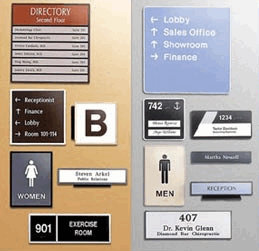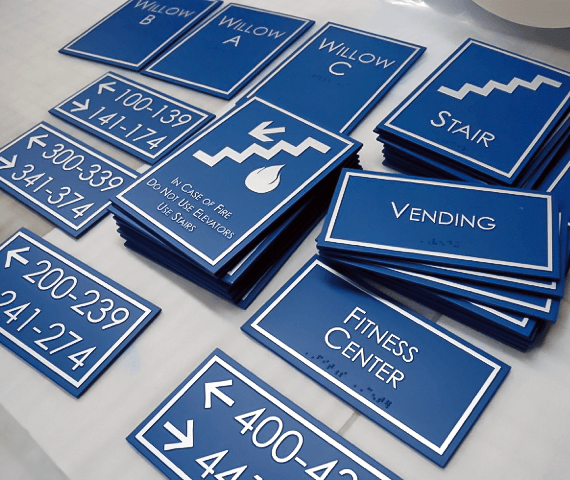A Comprehensive Guide to Picking the Right ADA Signs
A Comprehensive Guide to Picking the Right ADA Signs
Blog Article
Discovering the Key Features of ADA Signs for Boosted Availability
In the realm of availability, ADA indicators serve as silent yet effective allies, guaranteeing that rooms are accessible and inclusive for individuals with handicaps. By integrating Braille and tactile elements, these indicators damage obstacles for the aesthetically damaged, while high-contrast color plans and readable fonts provide to varied visual demands.
Relevance of ADA Compliance
Ensuring compliance with the Americans with Disabilities Act (ADA) is critical for cultivating inclusivity and equivalent access in public spaces and workplaces. The ADA, passed in 1990, mandates that all public centers, companies, and transport solutions suit people with disabilities, guaranteeing they enjoy the very same legal rights and chances as others. Compliance with ADA requirements not just fulfills legal obligations yet additionally boosts a company's online reputation by showing its dedication to variety and inclusivity.
One of the essential aspects of ADA conformity is the application of obtainable signs. ADA indications are created to ensure that individuals with disabilities can quickly navigate through rooms and buildings.
Additionally, adhering to ADA regulations can reduce the risk of legal consequences and potential fines. Organizations that fail to follow ADA standards may deal with charges or claims, which can be both economically challenging and destructive to their public photo. Thus, ADA conformity is essential to cultivating a fair atmosphere for everybody.
Braille and Tactile Aspects
The consolidation of Braille and responsive elements right into ADA signs personifies the principles of ease of access and inclusivity. These attributes are crucial for individuals that are visually impaired or blind, enabling them to navigate public areas with higher freedom and confidence. Braille, a tactile writing system, is essential in providing created info in a layout that can be quickly regarded via touch. It is commonly placed underneath the matching text on signage to make certain that people can access the information without visual aid.
Tactile components prolong beyond Braille and include raised personalities and symbols. These elements are made to be noticeable by touch, allowing individuals to determine area numbers, toilets, exits, and other vital areas. The ADA sets specific standards regarding the size, spacing, and positioning of these tactile elements to enhance readability and make sure uniformity across different settings.

High-Contrast Color Design
High-contrast color design play a critical function in enhancing the presence and readability of ADA signs for people with aesthetic problems. These plans are necessary as they make the most of the difference in light reflectance in between text and history, ensuring that indications are easily discernible, also from a distance. The Americans with Disabilities Act (ADA) mandates using certain color contrasts to fit those with limited vision, making it webpage a crucial aspect of compliance.
The efficiency of high-contrast colors lies in their capacity to stand out in numerous illumination conditions, consisting of dimly lit environments and locations with glare. Typically, dark text on a light background or light message on a dark history is used to accomplish ideal contrast. For example, black text on a yellow or white background supplies a plain aesthetic difference that aids in quick recognition and understanding.

Legible Fonts and Text Size
When taking into consideration the style of ADA signage, the choice of clear font styles and appropriate text size can not be overemphasized. These aspects are essential for ensuring that indications are accessible to people with visual problems. The Americans with Disabilities Act (ADA) mandates that fonts must be sans-serif and not italic, oblique, script, very decorative, or of unusual kind. These requirements help make certain that the message is conveniently legible from a range which the personalities are appreciable to varied audiences.
According to ADA standards, the minimal text elevation need to be 5/8 inch, and it must boost proportionally with checking out distance. Uniformity in text dimension contributes to a natural aesthetic experience, helping people in navigating settings effectively.
Moreover, spacing between letters and lines is indispensable to legibility. Adequate spacing prevents personalities from appearing crowded, boosting readability. By adhering to these requirements, designers can substantially boost access, ensuring that signs offers its intended function for all people, regardless of their visual capabilities.
Effective Positioning Techniques
Strategic positioning of ADA signs is vital for taking full advantage of ease of access and making sure conformity with lawful criteria. Correctly located indications lead people with impairments successfully, assisting in navigating in public spaces. Key considerations include exposure, closeness, and height. ADA standards stipulate that indications should be mounted at an elevation between 48 to 60 inches from the ground to guarantee they are within the line of sight for both standing and seated people. This typical elevation variety is crucial for inclusivity, enabling wheelchair individuals and people of varying elevations to gain access to information easily.
Additionally, indications should be placed adjacent to the lock side of doors to allow very easy identification before entry. Consistency in indication positioning throughout a learn the facts here now center enhances predictability, minimizing complication and boosting total customer experience.

Conclusion
ADA signs play a crucial function in promoting availability by incorporating features that address the needs of individuals with specials needs. Incorporating Braille and tactile aspects ensures essential info comes to the visually impaired, while high-contrast color pattern and clear sans-serif fonts boost presence throughout various lights problems. Effective positioning techniques, such as proper placing elevations and tactical locations, additionally help with navigation. These aspects collectively cultivate an inclusive atmosphere, underscoring the significance of ADA compliance in ensuring equivalent gain access to for all.
In the world of access, ADA signs offer as quiet yet effective allies, making certain that rooms are accessible and inclusive for people with impairments. The ADA, passed in 1990, mandates that all public centers, companies, and transportation services fit people with specials needs, ensuring they enjoy the exact same legal rights and chances as others. ADA Signs. ADA indicators are created to guarantee that individuals with impairments can conveniently navigate to these guys browse via structures and areas. ADA standards specify that signs ought to be placed at an elevation in between 48 to 60 inches from the ground to guarantee they are within the line of view for both standing and seated people.ADA signs play a vital function in advertising accessibility by incorporating functions that resolve the demands of people with impairments
Report this page